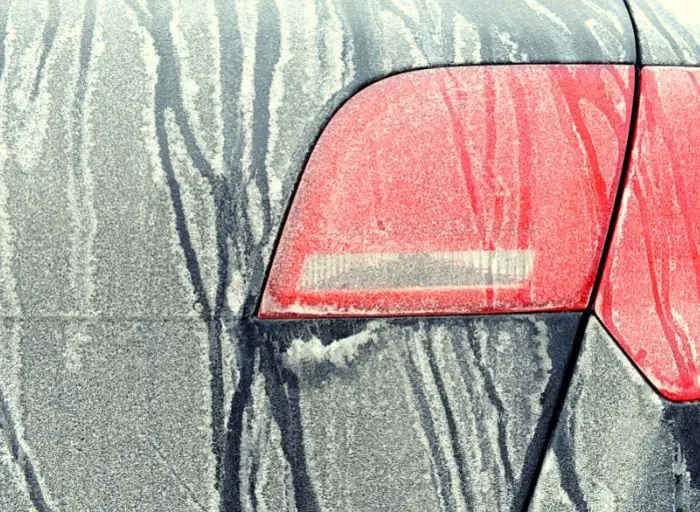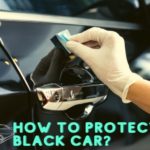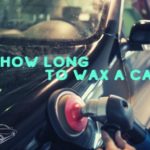
Your car’s paint won’t last indefinitely. There are numerous factors that cause automotive paint to deteriorate. As a result, several drivers want to discover what eats car paint the fastest.
Table of Contents
What Eats Car Paint the Fastest
The short answer is that salt and acid rain are the 2 most things that can eat car paint the fastest. Several fluids and liquids have a tendency to erode car paintwork as well, causing oxidization to begin sooner than planned.
Collisions can also result in severe scratches, which appear to scrape paint off the afflicted regions. Let’s talk about what takes the paint off a car.
What Takes Paint Off A Car Fast
| Factors | Rating |
| Acid Rain, Bird Droppings, and Insects | 9 |
| Salt and Road Salt | 9 |
| Acidic Substances | 8 |
| Harsh Chemicals and Cleaners | 8 |
| Road Debris and Gravel | 7 |
| Industrial Fallout | 7 |
| Tree Sap and Pollen | 6 |
| Sunlight and UV Radiation | 5 |
Below are very common factors that can take the paint off car fast:
1. Salt
You probably already know that salt eats your car’s paint faster than any other acidic or reactive material or liquid. Salt is a very acidic and reactive substance. Salt is such a potent material that it is used to keep ice off pathways in various parts of the United States during the winter.
If you drive in places where road salt is utilized, you’ll need to wash your car more frequently if you don’t want the paint to oxidize faster than intended.
So, how to keep your car’s paint from being eaten away by road salt? The most important thing to remember is to wash your car on a regular basis. Allowing the salt to rest on your paint for too long will cause it to oxidize. You should also consider waxing your car to help protect the clear finish layer from harm.
Waxing should also be considered as part of your winterizing routine. If you don’t want to apply wax on your car, sealants or other auto car compounds can provide further paint protection. If the damage has already been done, you’ll need an auto repair kit to repair it.
2. Acid rain
Because acid rain is one of the things that eats automotive paint the fastest, it is a major cause of paint damage. Acidic particles corrode paint and metal. Acid rain comprises nitric and sulfuric acid, which penetrate the top layer of paint and work their way down.
If your car is subjected to this corrosion, you may see peeling or chipped paint, eventually leading to rust. The easiest way to avoid this is to eliminate any acid rain evidence immediately.
3. Gas

Car owners should use caution when fueling their automobiles. The vehicle’s paint may be harmed if there is a spill or a drop. The remaining fuel after it has evaporated may cause damage to the clear coat. Having the car waxed on a regular basis is the easiest approach to avoid this problem. Cleaning will be a breeze, as well.
4. Coffee & Soda
Lots of folks aren’t aware that beverages like coffee and soda can harm your car’s paint. These beverages have high acidity levels, which can eat away at the paint’s protective layer and start corrosion.
Sugar in coffee and sugar in soda drinks causes a sticky film to form on the coffee’s surface. To avoid long-term repercussions, make it a point to wipe up any spills immediately.
5. Bird droppings
Surprisingly, bird excrement is another factor that wreaks havoc on car paint. Because bird droppings are acidic, they can permanently stain a car. When baked in the sun, they solidify onto the car paint.
How can you keep bird droppings off your car’s paint? Keep an eye on your vehicle and don’t let the droppings dry on the paint. To get rid of them as soon as possible, use a damp rag and a light detergent.
Also, avoid scratching the region when cleaning the excrement for grit and seed fragments in the waste that might scratch the paint.
6. Bugs
Insects are another common cause of paint deterioration on autos. Bug body fluid, like bird droppings, has high acidity and, like bird droppings, can dissolve your paint. While insects are unlikely to cause harm to the surface on the first touch, they might cause severe damage if left on your vehicle for a lengthy period of time.
If you discover insects on your vehicle, remove them as quickly as possible and properly clean the surface.
Allow 30 seconds for the cleaning solution to settle before delicately wiping the area with a towel to remove any leftover residue.
7. Snowfall
Snow is another common source of automotive paint damage. Snow, however, may actually be harmful to your car’s paint and other components. They may become entangled in the crevices and crannies of your vehicle’s body. This will result in scratches and rust, as well as the removal of the paint. Of course, rust could form as a result of the melting snow.
It’s critical to wipe off any snow that has adhered to your car as soon as you emerge from the snow to avoid a build-up that could cause further harm down the road.
8. Roads and driveways covered in tar
If you’re traveling on the highway, you’ve probably noticed tar ripples on the road that will eat away at your car’s paint if it gets stuck in the cracks. Even if you don’t want to consider it right now, you should be aware that it is possible when riding on any highway.
These tar rivulets should be avoided at all costs since they might harm your paint. They have a tendency to solidify and adhere to painted surfaces. As a result, removing it can be quite difficult, and the paint may be damaged in the process. To make things easier and safer, use a tar remover.
9. Brake fluid
In the automobile business, there has been a great deal of misunderstanding concerning the dangers of braking fluid. Experts say that not all braking fluids genuinely harm the car’s surface. However, you should use caution when working with brake fluids that are not silicone-based.
In general, this refers to older types of acidic braking fluid that may act as a paint stripper, causing the car’s outer layer to peel away. The introduction of more durable automotive coatings has also helped protect autos from various chemical exposures.
10. Car accidents
As previously indicated, collisions that create severe scratches on your car’s body appear to have removed some paint. The scratched spots will look whitish, indicating that no paint has been applied to those surfaces.
Despite the severity of the scratch, it may be repaired, and the body of your car will return to its original gleam.
You’ll need to get an orbital sander, polishing compound, scratch repair compound, and auto repair tools to repair collision-induced paint damage.
To fix the scratches, follow the instructions on the manual or label and apply the necessary compounds to fill in the missing paint.
How to Protect Your Car’s Paint
Prevention is key when it comes to maintaining your car’s paint. Here are some effective measures you can take to protect your car from paint damage:
Regular washing and waxing
Wash your car regularly to remove dirt, debris, and contaminants that can damage the paint. Apply a protective wax coating to create a barrier between the paint and external elements.
Avoid parking under trees
While trees provide shade, they also pose a risk of tree sap and pollen falling onto your car. Choose parking spots away from trees to minimize exposure.
Use car covers or garages
If possible, park your car in a covered garage or use a car cover when parking outside for extended periods. This protects your car from direct sunlight, bird droppings, and other environmental factors.
Address bird droppings promptly
If bird droppings soil your car, remove them as soon as possible. Use a gentle car cleaning solution and a microfiber cloth to avoid scratching the paint while cleaning.
Apply paint protection film (PPF)

The paint protection film is a transparent layer that can be applied to vulnerable areas of your car, such as the front bumper, hood, and side mirrors. PPF provides an extra layer of protection against scratches, chips, and stains.
Avoid harsh chemicals
When washing your car, use pH-neutral car cleaning products that are specifically formulated for automotive use. Avoid using household cleaners or abrasive substances that can damage the paint.
Regular maintenance
Keep up with routine maintenance, including inspections and touch-ups. Address any chips, scratches, or paint damage promptly to prevent further deterioration.
Consider ceramic coating
Ceramic coating is a protective layer applied to the paint surface, providing long-lasting protection against UV rays, chemicals, and contaminants. It enhances the paint’s gloss and makes it easier to clean.
Avoid automatic car washes
While convenient, automatic car washes can be harsh on your car’s paint. Opt for hand washing or touchless car washes that use gentle methods to clean the vehicle.
Avoid rough driving conditions
Be cautious while driving on gravel roads or in construction zones. Slow down to minimize the risk of debris hitting your car’s paint.
Check out this video for what automotive paint colors are in trend now!
FAQs
1. Can bird droppings damage car paint?
Yes, bird droppings contain acidic substances that can eat through the protective layers of car paint if left untreated. It is important to remove them promptly.
2. How often should I wash my car to protect the paint?
Regularly washing your car is recommended, especially if it gets exposed to dirt, dust, or environmental contaminants. Aim for at least once every two weeks, but adjust the frequency based on your specific circumstances.
3. Can tree sap be removed without damaging the paint?
Yes, tree sap can be safely removed by using specialized tar and sap removers. Follow the instructions carefully and avoid scraping the sap off, as it may cause scratches.
4. Does ceramic coating eliminate the need for waxing?
Ceramic coating provides long-lasting protection and enhances the paint’s shine, reducing the need for frequent waxing. However, applying wax on top of the ceramic coating for added protection and longevity is still advisable.
5. Are touchless car washes safe for my car’s paint?
Yes, touchless car washes use high-pressure water and gentle cleaning agents to clean your car without physically touching the paint. They are generally considered safe and less likely to cause scratches compared to traditional automatic car washes.
Conclusion
Protecting your car’s paint is essential for maintaining its appearance and value. By understanding the factors that can damage car paint and taking preventive measures, you can ensure that your car’s paint remains in excellent condition for years.
Further Reading:
Hi everyone, My name is Ollie Barker.
As a seasoned auto expert I have 25 years of experience working in repair and detailing shops. I love to share my tips & tricks to all car lovers, so that’s why I’m here at Automotive Gearz publishing my content, sharing my passion. Also, I’ve been giving my recommendations on which products are the best to have on the market. I always thought it was hard to pick the right part, so hopefully I can make that a bit easier for you.
Hope you enjoy your time on my little blog!







